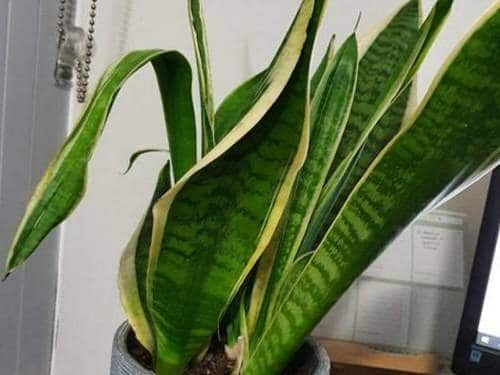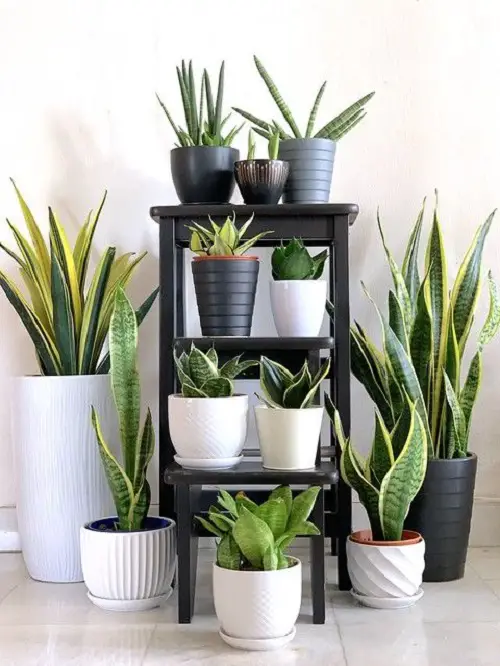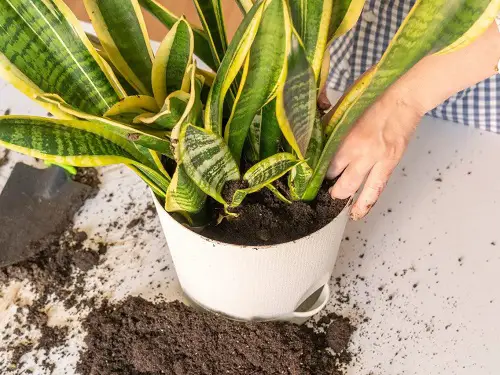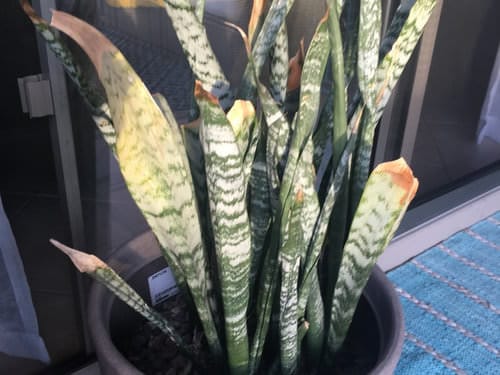Growing a Mother-in-Law’s Tongue plant in the home? Must check out these Healthy vs. Unhealthy Snake Plant differences.

Discover Healthy vs. Unhealthy Snake Plant and learn tips on how to maintain your snake plant’s optimal health. So, let’s dive in and learn how to keep your snake plant thriving!
What is a Snake Plant?
The Snake Plant has long, sword-shaped leaves that grow straight up from a rosette at the base. The leaves come in different shades of green and yellow, with various patterns that add to their beauty.
What makes the Snake Plant unique is that it is able to purify indoor air by removing harmful VOCs like formaldehyde, benzene, and xylene. To what extent–it’s debatable! It’s also an excellent plant to have in your bedroom because it is a CAM plant and has the ability to absorb CO2 even at night.
Another fantastic thing about this plant is that it’s super low maintenance and can thrive in low light and dry indoor conditions. So, even if you’re new to growing houseplants or have a busy schedule, you can still grow it.
Here are some amazing snake plant benefits
Healthy vs. Unhealthy Snake Plant
A Healthy Snake Plant
- A healthy snake plant is vibrant and full of life (not exactly jumping and dancing 😅, but yes, full of life). You’ll see its leaves will be thick and deep green in color, with no brown or yellow spots.
- The leaves should be long and straight, and the edges of the leaves should be smooth and even and a bit sharp (not exactly like a cactus, but a bit, yes 😌).
- The plant should also have a strong root system that is firmly in the soil. Its soil should be moist but not overly saturated. Additionally, the plant should be free of pests or diseases.
An Unhealthy Snake Plant
- An unhealthy snake plant is one that is weak and struggling (like a sad face 😭). Its leaves may be thin and pale green in color, with brown or yellow spots.
- The leaves may also be crooked or wilted. The plant might have a weak root system that is not firmly in the soil, or the soil may be overly saturated consistently.
- Additionally, the plant may have signs of pests or diseases, such as mold, mildew, or insects (exactly similar to someone who is sick 🤒).
Healthy vs. Unhealthy Snake Plant – Major Points to Notice
1. Appearance
The appearance of a healthy snake plant is one of its most attractive features. The plant typically has several thick, upright leaves with a smooth, glossy surface. The leaves are usually a dark green color with yellow or white stripes running across them.
The leaves may be arranged in a rosette formation, with the taller leaves in the center and the shorter ones on the outside. They can grow up to three feet in length (or more, depending on the variety 🌴) and be up to an inch wide. The edges of the leaves are usually pointed, giving the plant its namesake.
An unhealthy snake plant may have yellow or brown patches on its leaves, or the leaves may be drooping or wilting. The leaves may also be thin and lack the glossy sheen of a healthy plant.
They are usually dry and brittle or have a powdery coating on them. The plant may also have black or brown spots on the leaves, which indicate a fungal or bacterial infection. It may also have slower growth than usual or may be losing its leaves prematurely.
2. Growth

When healthy, snake plants are fast-growing (compared to the unhealthy ones 🏃🏻♀️) and can survive with minimal water. They will also tolerate low light and neglect but thrive best in bright, indirect sunlight.
Snake plants prefer well-draining soil that is slightly acidic and needs to be watered only when the soil is completely dry.
When unhealthy, snake plants will exhibit signs of distress, such as yellow or brown leaves, stunted growth, or wilting. Poorly-draining soil, overwatering, and low light levels can cause snake plants to become unhealthy.
Find How to Grow a Big Snake Plant
3. Smell
The smell of a healthy snake plant is generally considered to be neutral and should not have any strong foul odor.
On the other hand, the roots of unhealthy snake plants can have a musty or unpleasant odor. This could be caused by a number of factors, such as overwatering, inadequate drainage, insufficient light, or pests.
It is important to address the underlying issue causing the unpleasant odor in order to ensure the health of the plant.
4. Pests and Diseases
Healthy Snake Plants are relatively resistant to pests and diseases, but an unhealthy plant may be susceptible to spider mites, mealybugs, or fungal infections.
Keep an eye out for any signs of infestation or disease, such as webs, small white bugs, or black spots on the leaves.
5. Root System
Healthy Root System
The root system of a healthy snake plant should be strong, white, and plump. The roots should be firmly attached to the soil and display a “fibrous” quality.
There should be healthy growth, with the roots evenly distributed throughout the pot. The roots should feel firm to the touch, and they should not be too wet or too dry.
Unhealthy Root System
An unhealthy root system of a snake plant will be discolored or wilted. The roots may be dry and brittle, or they may have a slimy texture.
There may be signs of rot or disease, such as brown or black spots on the roots. The roots may also be tangled and overcrowded, indicating that the plant is pot-bound.
Top Tips to Keep Snake Plants Healthy?
- Water your Snake Plant only when the top inch of soil is dry to the touch. Overwatering can cause root rot, so be sure to let the soil dry out between waterings.
- While these plants do well in the shade, it is important to keep them in a spot that gets indirect and bright light all day long. Also, keep on rotating it once in 3-4 weeks to ensure every part gets equal sun exposure.
- Keep your Snake Plant away from cold drafts or temperatures below 50°F (10°C), as this can cause damage to the leaves.
- Use a balanced fertilizer during the growing season (spring and summer) to promote healthy growth. Only fertilize your plant sparingly to avoid burning the roots.
- Keep your plant looking its best by wiping its leaves with a damp cloth to remove dust and debris.
- Every 2-3 years, repot your Snake Plant into a larger pot with fresh soil to allow for healthy root growth.
- Trim off any yellow or dead leaves to prevent the disease from spreading to healthy leaves.
- Keep a lookout for pests and diseases such as spider mites, mealybugs, or fungal infections, and treat them immediately if you notice any signs of infestation or illness.






